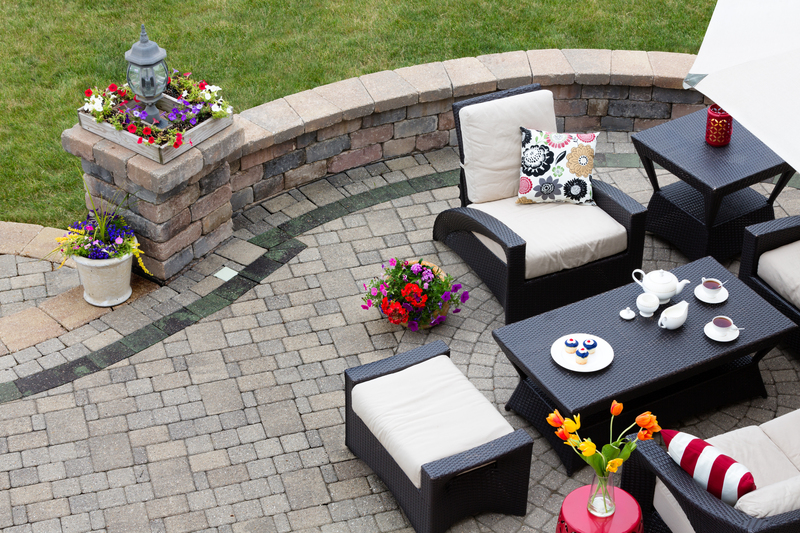From Neglect to Nurture: Beginning Your Garden's Renewal
Posted on 30/06/2025
From Neglect to Nurture: Beginning Your Garden's Renewal
Is your outdoor space crying out for attention? Perhaps your garden has seen better days, with overgrown weeds, tired soil, or forgotten corners. If so, you're not alone. Many homeowners and garden enthusiasts find themselves overwhelmed by neglected gardens but dream of transforming them into vibrant outdoor havens. Renewing your garden is not only possible, but it can also be one of the most rewarding and therapeutic projects you undertake. Let's explore actionable steps and expert tips to begin the journey from neglect to nurture.

Understanding the State of Your Neglected Garden
Before you can start the renewal process, it's essential to assess your garden's current condition. Think of this as the foundation for your garden revival. By clearly understanding what you're working with, you can tackle issues systematically, avoid costly mistakes, and set realistic goals for your garden transformation.
Signs Your Garden Needs Renewal
- Weeds and invasive plants dominating flower beds or lawns
- Compacted or barren soil lacking nutrients
- Abandoned or broken garden structures (fences, raised beds, pathways, furniture)
- Plants suffering from disease, neglect, or drought
- Poor or nonfunctional irrigation systems
- Lack of biodiversity and pollinator-friendly plants
- Overgrown trees and shrubs that hinder sunlight
Survey your space, take notes, and even snap photos. This will help you track progress and create a realistic plan for your garden's renewal.
Setting Clear Goals for Your Garden's Restoration
Every garden--no matter how neglected--has enormous potential. Setting clear intentions is vital for a successful garden revival journey.
- Define your vision: Do you dream of a relaxing sanctuary, a productive vegetable patch, or a space for entertaining?
- Consider practical needs: Will children or pets use the area? Do you hope to attract wildlife or grow your own food?
- Assess your resources: How much time and budget can you dedicate to this renewal?
Setting realistic and specific goals will keep you motivated and help prioritize tasks. Small, achievable milestones--like reviving one flower bed at a time--can prevent overwhelm.
Clearing the Slate: Tackling Overgrowth and Debris
The first hands-on stage in restoring your neglected garden is clearing out the "old" to make space for the "new." Approach this with patience and strategy--it's a key step in your garden renewal adventure.
Top Tips for Clearing an Overgrown Garden
- Start with big items: Remove large debris, such as fallen branches, trash, or dilapidated structures. This helps you see the space and access beds or borders more easily.
- Tame unruly growth: Prune back overgrown shrubs, hedges, and small trees. Cut back perennials to encourage fresh growth.
- De-weed thoroughly: Uproot invasive weeds and grasses by the roots to reduce regrowth. Lay down cardboard or weed-suppressing fabric where necessary.
- Compost green waste: Use organic matter to enrich your soil in the long run--renewal is about recycling too!
- Divide and conquer: Work on small sections at a time to keep progress manageable and satisfying.
After this stage, your garden will look empty--but full of potential. This blank slate is your canvas!
Soil Rejuvenation: The Heart of Garden Renewal
The soul of any thriving garden is its soil quality. Years of neglect often result in compacted, depleted, or unbalanced soil. Rejuvenating your garden begins from the ground up.
Steps for Restoring Neglected Soil
- Test your soil: Use a home soil test kit to check pH levels and assess nutrient deficiencies such as nitrogen, phosphorous, and potassium.
- Enrich with organic matter: Mix compost, well-rotted manure, or leaf mold into garden beds and borders to boost fertility and structure.
- Aerate compacted areas: Use a garden fork or aerator to loosen soil, allowing roots to penetrate more easily and water to reach deeper layers.
- Mulch, mulch, mulch: A good layer of mulch suppresses weeds, retains moisture, and breaks down into vital nutrients over time.
Repeat these steps yearly for continuous improvement, and notice how nurtured soil leads to healthier, more resilient plants.
Smart Garden Planning for Lasting Renewal
Renewal isn't only about restoring the old--it's about reimagining and future-proofing your garden. Thoughtful garden design will prevent future neglect and make maintenance easier.
Design Tips for Low-Maintenance, Resilient Gardens
- Choose hardy, native plants: Select plants suited to your climate and soil conditions for less fuss and more reward.
- Plan for seasonal interest: Mix early spring bulbs, summer perennials, autumn foliage, and winter evergreens to keep your garden lively year-round.
- Group plants by water needs: Reduces overwatering and unnecessary waste.
- Create paths and access points: Easy access means higher likelihood of regular care.
- Install efficient irrigation: Drip systems or soaker hoses maximize watering efficiency and minimize labor.
Investing time in smart planning now saves you time and energy in years to come, ensuring your garden renewal endures.
Planting for Success: Making the First Green Choices
With your space cleared and soil revived, it's time for the most exciting part: introducing new life! Think carefully about your first plants, as they set the tone for your garden's future.
Starter Planting Tips for the Renewed Gardener
- Start small: You don't need to plant everything at once. Begin with a few hardy shrubs, flowering perennials, or a patch of herbs.
- Focus on foundation plants: Evergreens and structural plants create year-round "bones" on which to build seasonal displays.
- Incorporate pollinator plants: Lavender, echinacea, and native wildflowers attract bees and butterflies, boosting biodiversity.
- Add containers and raised beds: Great for fast results in neglected spots, containers can be filled with colorful blooms or vegetables.
- Allow for growth: Space plants to accommodate their mature size and create a healthier, less crowded garden.
Be patient. A new garden may look sparse at first, but in just a few seasons your nurture will pay off handsomely.
Watering, Feeding, and Ongoing Care: Building Resilience
Consistent, thoughtful care is the secret to ensuring your garden renewal remains a permanent transformation. Nurturing routines are easier (and more enjoyable) once your space is organized and revitalized.
Best Practices for Daily and Seasonal Garden Care
- Establish a watering schedule: Water early in the morning or late in the evening to minimize evaporation. Check soil moisture before adding more water.
- Feed intelligently: Use slow-release, organic fertilizers appropriate for plant needs and apply during active growth periods.
- Weed routinely: Nip weeds in the bud before they can overwhelm new plantings. Mulching helps minimize this chore.
- Monitor for pests and disease: Early intervention is easier; encourage natural predators with a diverse planting scheme.
- Prune and deadhead: Regularly trim dead or damaged growth to encourage healthy new shoots and more flowers.
Even as little as 10-15 minutes a day can keep your garden on a nourishing path and prevent future neglect.
Adding Structure and Finishing Touches
With the basics in place, give your garden personality and polish by adding architectural and decorative elements.
- Restore or replace hardscaping: Freshen up old fences, edge pathways, mend raised beds, or replace broken seating.
- Install focal points: Consider birdbaths, garden sculptures, or even a cozy bench to invite you outdoors.
- Incorporate lighting: Solar stakes and fairy lights add ambiance and extend garden enjoyment into the evening.
- Define spaces: Use archways, trellises, or espaliered trees to subtly separate play zones, dining areas, or quiet corners.
These enhancements make your renewed garden feel intentional and welcoming, inspiring regular visits--and ongoing nurture.
Embracing Sustainability in Your Garden's Revival
Modern garden renewal is about more than just aesthetics. By adopting sustainable practices, you nurture not only your own sanctuary but also contribute positively to your local ecosystem.
Easy Ways to Nurture a Sustainable Garden
- Compost organic waste: Turn kitchen and garden scraps into black gold to feed your soil.
- Harvest rainwater: Install barrels to capture free, natural irrigation.
- Plant for wildlife: Choose flowers for pollinators, install bird feeders, or leave a pile of logs for beneficial insects.
- Minimize chemical use: Favor natural pest control and gentle fertilizers for a living, resilient ecosystem.
- Reuse and upcycle: Convert old pallets into compost bins or use reclaimed bricks for pathways.
By embedding these principles into your garden's renewal, you foster a healthier, happier outdoor space for generations.

Staying Inspired: Celebrating Progress and Embracing Change
Reviving a neglected garden is a journey--a little can go a long way, and every success is worth celebrating. Remember, it's normal for gardens to evolve over time.
- Document your journey: Take before-and-after photos, keep a garden journal, and note new achievements.
- Share with community: Join local gardening clubs or online groups for support, advice, and encouragement.
- Stay curious: Experiment with new plants, design trends, or cultivation methods as your confidence grows.
Progress not perfection is the mantra. Each step you take--from clearing out weeds to planting your first flower--brings new life and joy to your home.
Conclusion: Your Path from Neglect to Nurture
Turning around a neglected garden may seem daunting, but with patience, planning, and persistent effort, you'll witness an outdoor transformation that soothes, satisfies, and inspires. Remember to assess your garden, set achievable goals, start with small projects, and nurture your space consistently. Incorporate sustainable practices and let your creativity shine as you shape your outdoor retreat.
Above all, enjoy the process! Every gardener--novice or experienced--knows that renewal is a continual cycle, and every act of nurture is met with abundant rewards. May your journey from neglect to nurture bring beauty, relaxation, and connection with nature for years to come.

